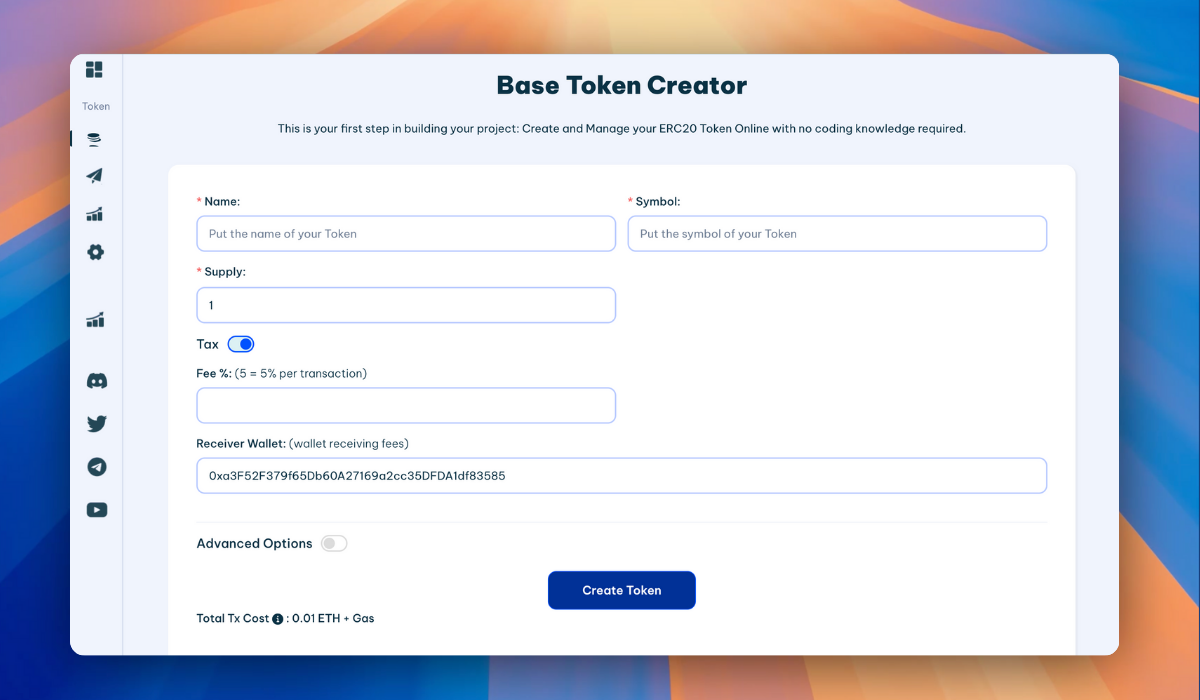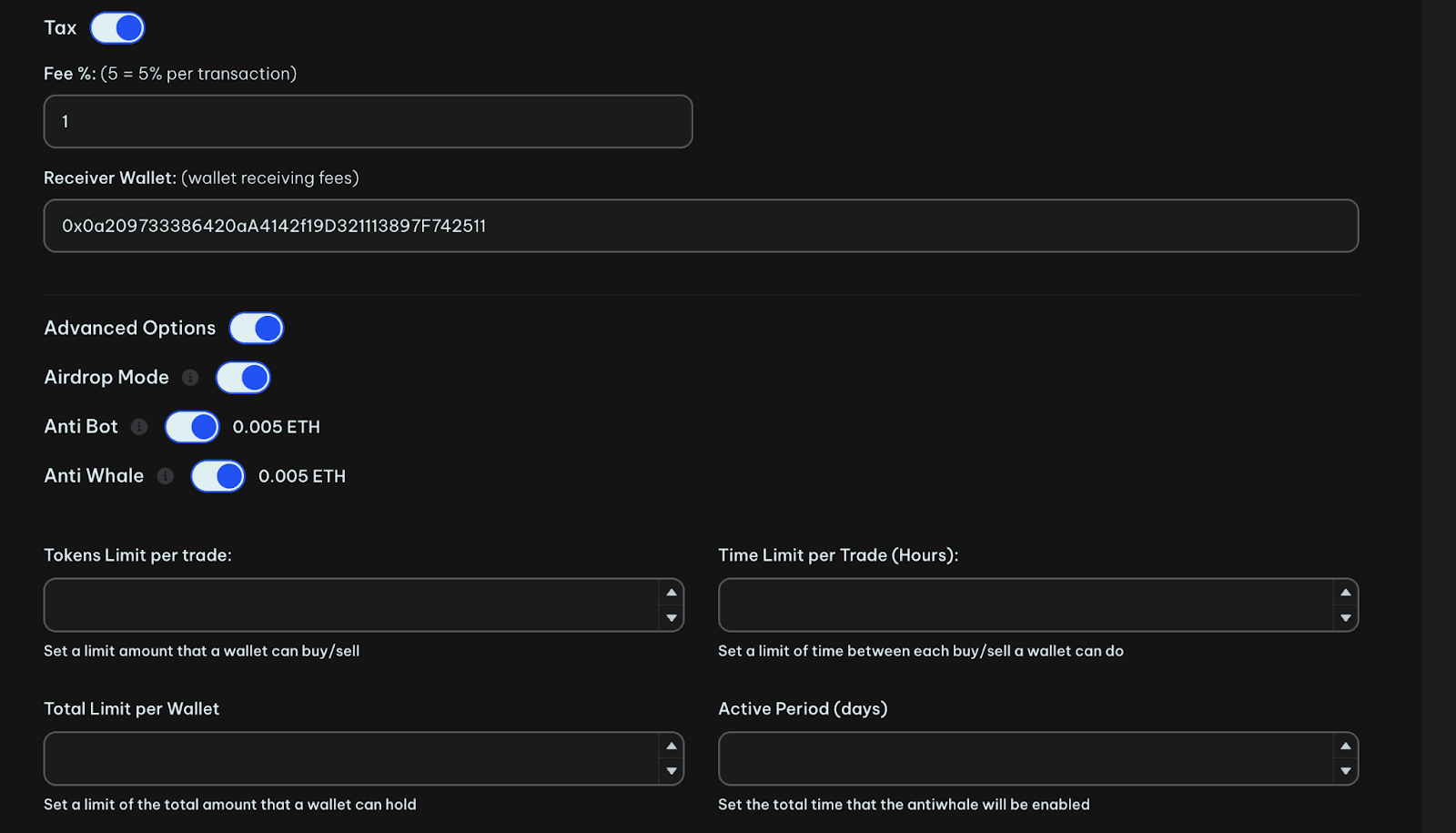Base is an Ethereum layer-2 blockchain that has grown in popularity thanks to its low fees, minimal congestion, and the security guarantees it inherits from EVM. The blockchain has become a compelling option for those who want to create and launch their own tokens in 2024. This guide demonstrates step-by-step how to create a token on the Base blockchain without any programming skills. Here’s what to know.
In this guide:
- How to create a token on Base: Step-by-step
- Launching your token: Creating a liquidity pool
- Understanding the basics of Base tokens
- Why create a token on the Base blockchain?
- What you need to create a token on Base
- Listing your Base token on exchanges
- What is an ERC20 token?
- No code token creation opens new possibilities
- Frequently asked questions
How to create a token on Base: Step-by-step
Using the Base Token Creator from Smithii Tools (a protocol fully audited by CoinFabrik), you can create a token on the Base blockchain in just a few simple steps — no coding required. In short, you must:
- Connect your wallet to the Base Token Creator tool
- Enter and define your token’s details
- Customize using advanced features (if you choose to)
- Confirm your choices.
Here’s what the process looks like in a little more detail.
Step 1: Connect your wallet
To get started, visit the Base Token Creator tool. Then, connect your Base-compatible wallet, such as MetaMask or Coinbase Wallet.

Create token: Base token creator
Step 2: Define your token’s details
Next, you’ll need to enter the basic details of your token:
Name: Choose a unique name for your token that reflects its purpose or branding.
Symbol: Select a symbol (usually a 3-4 letter abbreviation) representing your token in wallets and exchanges.
Supply: Determine your token’s total supply. This is the maximum number of tokens that will be minted and distributed.

Adding hypothetical details: Smithii
Step 3: Utilize advanced options (Optional)
For those looking to customize their token further, the Base Token Creator offers several advanced features:
Tax: Set a transaction fee to be retained with each token transfer and specify the wallet address to receive these fees. This feature is useful for generating revenue or funding future development.
Airdrop mode: Enable this mode to prevent users from sending or trading your token until you deactivate it. This can be useful during the initial distribution phases.
Anti-bot protection: Limit the impact of bots on your token’s liquidity pool by setting restrictions on the time interval between transactions for each wallet. This doesn’t allow a wallet to make more than a transaction within the same block.
Anti-whale mechanism: Protect your token from large holders who could potentially manipulate the market by setting limits on the amount a single wallet can buy or sell and the total number of tokens one wallet can hold.

Setting up advanced options: Base Token Creator
Step 4: Create your token on Base

Ensure you are on the Base mainnet: Base Token Creator
Double-check that your wallet is connected to the Base mainnet. Click the “Switch wallet” button as shown above if not.
After entering all the necessary information and configuring any desired advanced options, you can click “Create Token.” Confirm the transaction in your wallet; within moments, your token will be created and visible in your wallet.

Create token once you are sure about the details: Base Token Creator
Launching your token: Creating a liquidity pool
Once your token is live on the Base blockchain, creating a liquidity pool is next. This is crucial for enabling trading on decentralized exchanges like Uniswap. Here’s how you can do it:
- Go to the Create Liquidity Pool online tool, make sure you have the Base blockchain selected, and connect your preferred wallet.
- Choose the “Base Token” (usually $WETH, $USDT, $USDC, etc.) that defines the price.
- Choose the “Quote Token”; this is your token ready to go to market.
- Add Liquidity, choose the Base Token and Quote Token amounts to be matched; this defines the initial price of your token.
- Click on “Create Liquidity Pool” and accept the transactions.
Seconds later, you will have your liquidity pool created. It is launched in Uniswap; you can go there to see it. The cost of creating a Base liquidity pool in Smithii is 0.001 WETH, which includes the fees for creating the token pair and the liquidity pool.
Understanding the basics of Base tokens
Since Ethereum’s inception in 2015, one of the main hurdles in utilizing this blockchain and the wider crypto ecosystem has been the need for advanced programming skills to initiate a project.
Specifically, writing a smart contract in Solidity, Ethereum’s native programming language, is essential.
However, the emergence of low-fee chains like Base and decentralized applications (DApps) has simplified these processes, making it possible to create ERC20 tokens without needing any coding expertise and without spending hundreds of USD within the process.

Why create a token on the Base blockchain?
The decision to create a token on the Base blockchain comes with several advantages:
Low transaction fees: One of the most significant benefits of using Base is the reduced cost of transactions. Compared to Ethereum, which can suffer from high gas fees during periods of network congestion, Base offers a more cost-effective solution for token creation and transactions.
Scalability and speed: As a layer-2 solution, Base is designed to quickly handle a high volume of transactions, making it ideal for projects anticipating significant user interaction or requiring frequent transactions.
Security and compatibility: By adhering to ERC20 standards and operating as a layer-2 blockchain on Ethereum, Base inherits Ethereum’s top-end security features. This ensures that your token benefits from the same level of protection as those on the Ethereum mainnet.
Early adoption opportunities: Base is still in its growth phase, which means that early adopters can establish their presence in an ecosystem that is likely to expand. Being among the first to launch a token on Base can provide a competitive edge.
What you need to create a token on Base
As demonstrated in the process above, creating a token on the Base blockchain is straightforward. Still, you will need to prepare a few things beforehand:
- Compatible wallet: First and foremost, you need a wallet that supports transactions on the Base blockchain. Popular options include MetaMask and Coinbase Wallet, which are widely used and easily set up.
- Funds in your wallet: To cover the cost of creating your token, you’ll need a small amount of ETH in your wallet. The Base Token Creator tool from Smithii costs 0.01 ETH, making it an affordable option for most users.
- Marketing plan: While optional, having a solid marketing plan can significantly enhance the success of your token. Whether you use your token for governance, payments, or as a meme coin, a well-thought-out marketing strategy will help you reach your target audience and build a community around your project.
Listing your Base token on exchanges
Consider listing your token on platforms like CoinMarketCap and CoinGecko to gain broader visibility and attract more users. These listings are free but require you to complete an application.
Listing on these platforms will help your token reach a wider audience and provide valuable market data that users can rely on.
What is an ERC20 token?
ERC20, which stands for Ethereum Request for Comment 20, is a technical standard used to create fungible tokens and transferable digital assets on the Ethereum blockchain and other EVM-compatible networks like Base, Coinbase’s native blockchain.
Unlike Bitcoin, which operates on its blockchain, an ERC20 token exists on the Ethereum blockchain and uses its network for transactions and fees.
Over time, the ERC20 standard has become widely adopted. This has enabled seamless interaction between wallets, exchanges, and all Ethereum-based platforms, as they all follow the same rules.
Applications of ERC20 tokens on Base
Businesses and organizations leverage ERC20 tokens on Base Blockchain for various purposes. Some of the most common use cases include:
Asset tokenization: ERC20 tokens facilitate the conversion of physical assets, such as real estate or artwork, into digital tokens. This process makes these assets easier to trade and more accessible to a wider audience of investors. Due to the low fees, this is particularly useful on Base.
Governance: Organizations can enable governance mechanisms by distributing tokens on Base within a community. Token holders can exercise voting rights within decentralized autonomous organizations (DAOs), allowing for decentralized decision-making.
Decentralized finance (DeFi): Base tokens play a crucial role in DeFi by enabling complex financial transactions. They can represent stakes in liquidity pools and support automated processes, making financial operations more efficient.
Loyalty and rewards programs: Businesses can create Base tokens for loyalty and rewards programs, encouraging ongoing engagement and customer loyalty through token-based incentives.
Fundraising: ERC20 tokens are commonly used in fundraising efforts, mainly through Initial Coin Offerings (ICOs), where they serve as digital currencies to attract investment.
Meme coins: An ERC20 token can be a meme coin; it only depends on the nature given to the token at the moment it is created. Within Base, meme coins have been a key growth driver in 2024.
No code token creation opens new possibilities
Creating a token on the Base blockchain is not just about launching a digital asset; it’s about establishing a presence in a quickly maturing ecosystem. Whether you’re a developer, a project owner, or an entrepreneur, the ability to create a token without coding knowledge opens up new possibilities for innovation and engagement in web3.
What was once a complex process is now accessible to anyone with a vision and a wallet. By planning your token’s launch, including its marketing strategy and liquidity management, you can ensure that it stands out in the increasingly competitive blockchain world.







Leave a Reply